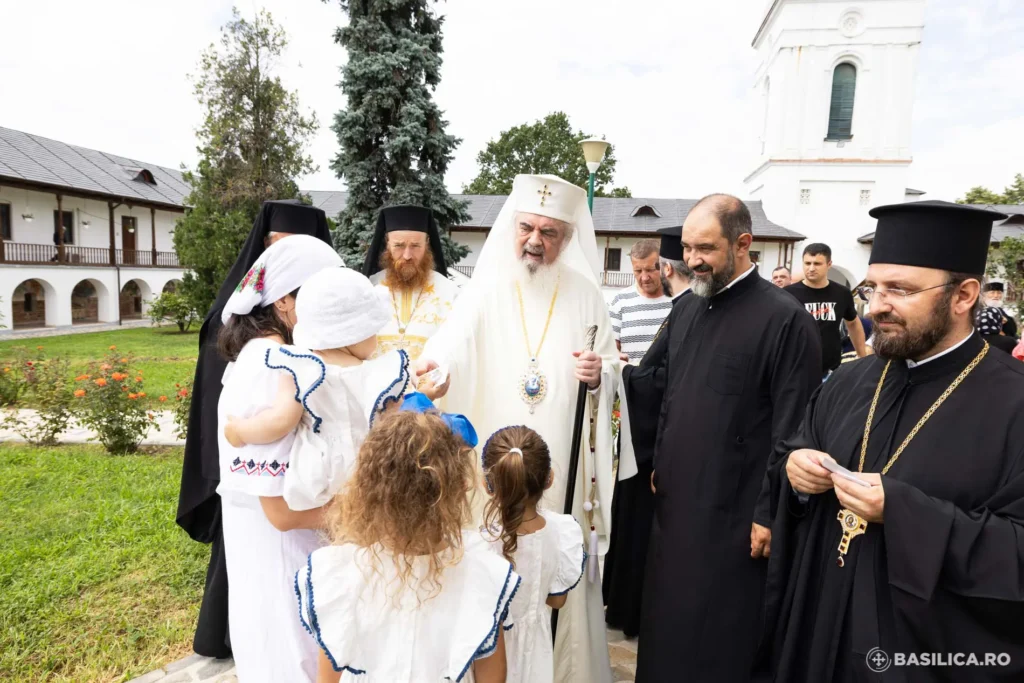On Tuesday, Patriarch Daniel participated in the historic patronal feast of Cernica Monastery. There, he spoke to the faithful about Christ’s glory, the reasons it was revealed on Mount Tabor, and the event’s significance. At the end of the service, the Patriarch of Romania was congratulated on the 37th anniversary of his monastic tonsure.
The festal Divine Liturgy was conducted by an assembly of priests led by Archimandrite Nectarie Șofelea, the administrative exarch of the Archdiocese of Bucharest.
The Glory of Christ
Referring to the hymns of the feast, His Beatitude noted that “the glory that the apostles Peter, James, and John saw was the paternal glory of the Heavenly Father, which He shares with His Son and the Holy Spirit, Who appears as a luminous cloud, and also with the disciples.”
This glory was revealed to the disciples as much as they could bear it, “that is, not in its entirety but adapted to the human condition, which is limited. Had they been overwhelmed by all the glory, they would not have withstood it,” Patriarch Daniel explained on August 6.
“This glory of Christ on Mount Tabor was the light with which the soul and body of the first man, Adam, were clothed before his fall into sin and disobedience. Since he was darkened by disobedience and expelled from the paradise of happiness, the new Adam, Jesus Christ, became incarnate and brought those who believe in Him to the light of the glory of the kingdom of heaven.”
“Thus, Christ restored to us the glory that the first Adam was supposed to reach if he had been obedient,” emphasized His Beatitude Patriarch Daniel.
Why the glory was revealed
“The hymns of today’s feast recall that Jesus revealed God’s glory to the three disciples so that when they would see Him disfigured by pain on the cross when He would be crucified, they would remember Him, the transfigured Jesus, glorified with divine glory, to encourage themselves and to know that the One who dies on the cross dies willingly and is the Lord of Glory. His death and resurrection are His will and are part of the plan of salvation and the deification of man,” detailed the Patriarch of Romania.
“This was the intention and wise pedagogy of the Saviour Jesus Christ: to prepare His disciples for the great suffering of seeing Christ crucified on the cross and His death.”
The Transfiguration did not occur in August
His Beatitude also discussed the historical context of the Feast of the Transfiguration of the Lord, noting that the event did not occur in August but rather two to three weeks before the Lord’s death and resurrection.
The Church Fathers who established the feast in the calendar did not consider the timing from the Gospel but set the feast on August 6 because it was the date of the consecration of a church on Mount Tabor.
The Patriarch explained that the choice of date is also related to the fact that August is the last month of the ecclesiastical year, reserved for final events, and the Transfiguration prefigures the glory of Christ’s second coming.
The only way to see God
The Romanian Patriarch noted that both Moses and Elijah could not see God’s face while they were on earth, but on Tabor, they spoke with Him face to face.
“Neither Moses nor Elijah could see God’s face while they lived on earth because the eternal Son of God had not yet taken human form, but after Jesus, the eternal Son of God, became incarnate and became man, they could see God’s face through the human face of Jesus.”
“Therefore, the only way to see God is through the human face of His Son, which is full of glory.”
The Face of Jesus
Patriarch Daniel then mentioned that the Gospels “do not tell us the colour of the Saviour’s eyes or the colour of His skin or complexion,” although later tradition tried to describe Jesus’s face as He lived among people on earth.
“The Gospels recorded only Jesus’s face full of glory: His face shone like the sun, and His garments were white as light. This is what we will see in eternity.”
“That’s why the Gospels said nothing about the colour of His skin, hair, or eyes because all things related to matter are transient in this world. What remains eternal is the presence of divine grace in the soul of man.”
Gifts and Celebrations
Finally, the Patriarch of Romania offered Cernica Monastery several books and natural incense from Oman. The monastery’s abbot, Protosyncellus Vasile Pârjol, congratulated the Patriarch on completing 37 years of monastic life and presented him, on behalf of the monastic community, with an icon depicting Saint George of Cernica and a basket of flowers.
After Saint Callinicus’s canonization, the historic patronal feast of Cernica Monastery, namely the Transfiguration of the Lord, was given a secondary role. Since 2020, the monastic settlement has resumed celebrating this feast, which was granted by Saint Callinicus in 1842 following some restoration works.
Photography courtesy of Basilica.ro / Raluca-Emanuela Ene
